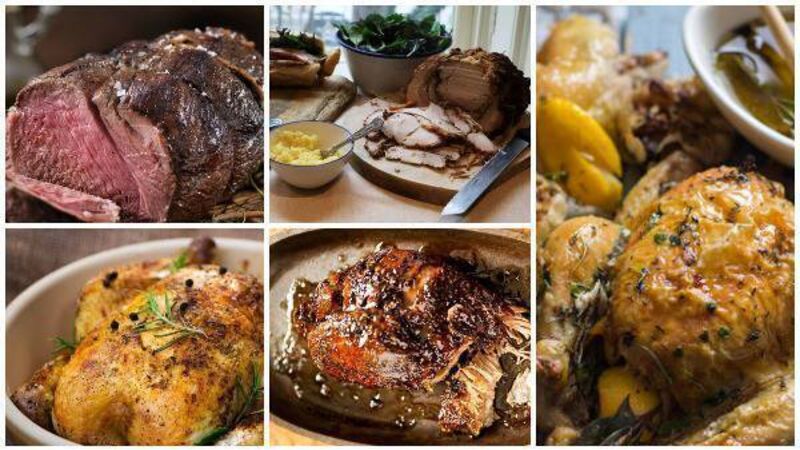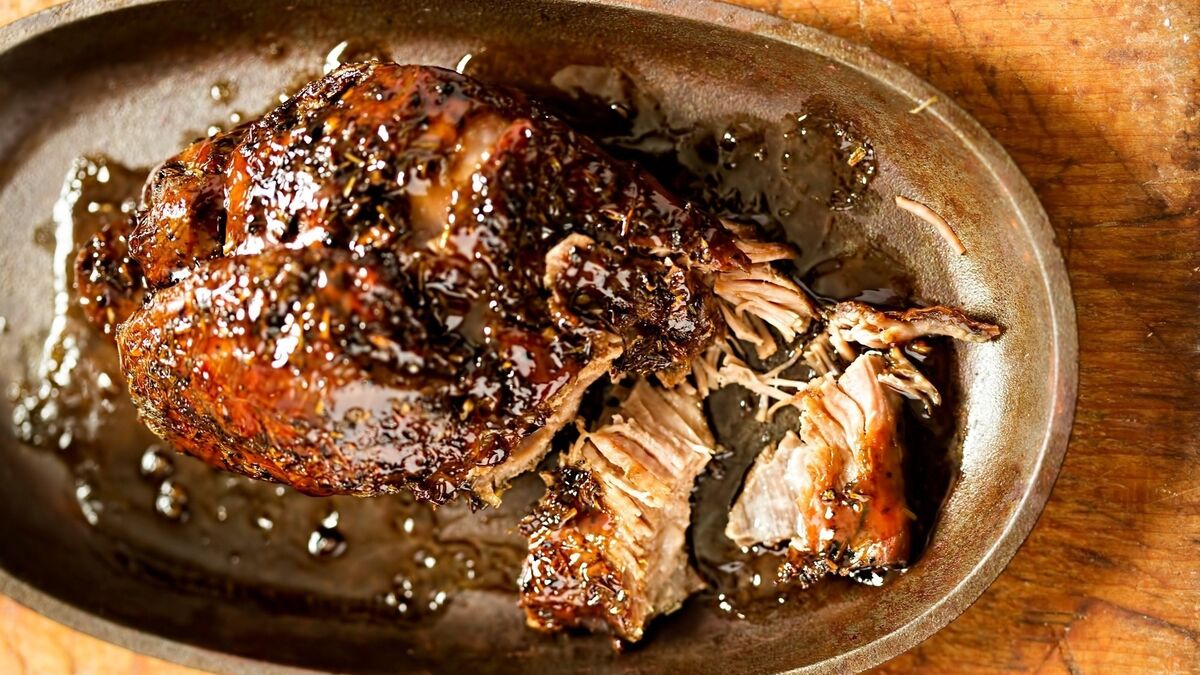Something for the weekend: Unwind with five of our most popular roast dinner recipes

Roast dinners are the best dinners.
Traditional roast stuffed chicken with gravy
Indulge in a classic Sunday roast chicken with stock, stuffing and gravy, complete with fresh herbs for enhanced flavour

Servings
6Preparation Time
30 minsCooking Time
1 hours 20 minsTotal Time
1 hours 50 minsCourse
MainIngredients
1.5-2.3kg chicken
For the giblet stock:
giblets (keep the liver for a chicken liver pate), and wishbone
1 carrot, thickly sliced
1 onion, thickly sliced
1 stick celery, sliced
a few parsley stalks and a sprig of thyme
For the stuffing:
45g butter
75g onion, chopped
75-100g soft white breadcrumbs
2 tbsp fresh herbs, finely chopped (parsley, thyme, chives and annual marjoram)
salt
freshly ground pepper
a little soft butter
For the gravy:
600-900ml stock from giblets or chicken stock
To garnish:
sprigs of flat parsley
Method
You may wish to make a basic brine to nehance the flavour of the chicken. Mix together 5 cups water and 105g salt in a suitable size container with a cover (stainless steel, plastic or enamel are ideal). A little sugar may be added to the brine, even a few spices. Add the bird or joint, cover and chill in a refrigerator or keep in a cool place and brine for chosen time. Drain well and dry before cooking.
First remove the wishbone from the neck end of the chicken, this is easily done by lifting back the loose neck, skin and cutting around the wishbone with a small knife – tug to remove, this isn't at all essential but it does make carving much easier later on. Tuck the wing tips underneath the chicken to make a neat shape. Put the wishbone, giblets, carrot, onions, celery and herbs into a saucepan. Cover with cold water, bring to the boil, skin and simmer gently while the chicken is roasting. This is the basis of the gravy.
Next make the stuffing, sweat the onions gently in the butter in a covered saucepan until soft, 10 minutes approx. then stir in the white bread crumbs, the freshly chopped herbs, a little salt and pepper to taste. Allow it to get quite cold unless you are going to cook the chicken immediately. If necessary wash and dry the cavity of the bird, then season and half fill with stuffing. Season the breast and legs, smear with a little soft butter.
Preheat the oven to 180°C. Weigh the chicken and allow about 20 minutes to the 454g and 20 minutes over — put on middle shelf in oven. (One hour and twenty minutes for a 1.5kg chicken.) Baste a couple of times during the cooking with the buttery juices. The chicken is done when the juices are running clear.
To test prick the thickest part at the base of the thigh, hold a spoon underneath to collect the liquid, examine the juices - they should be clear.
Remove the chicken to a carving dish, keep it warm and allow to rest while you make the gravy.
To make the gravy , tilt the roasting tin to one corner and spoon off the surplus fat from the juices and return the roasting pan to the stove. De-glaze the pan juices with the fat free stock from the giblets and bones (you will need 1-1 1/2 pints depending on the size of the chicken). Using a whisk, stir and scrape well to dissolve the caramelised meat juices in the roasting pan. Boil it up well, season and thicken with a little roux if you like (the gravy should not be thick). Taste and correct seasoning, serve in a hot gravy boat.
If possible serve the chicken on a nice carving dish surrounded by crispy roast potatoes and some sprigs of flat parsley then arm yourself with a sharp knife and bring it to the table. Carve as best you can and ignore rude remarks if you are still practicing but do try to organise it so that each person gets some brown and some white meat. Serve with gravy and bread sauce.
Use the cooked carcass for stock.
Roast beef with spring onions, anchoiade and pepper pesto
For the perfect Sunday roast, try beef with pan-grilled sping onions, anchioade with a mustard twist and roasted pepper pesto

Servings
8Preparation Time
60 minsCooking Time
40 minsTotal Time
1 hours 40 minsCourse
MainCuisine
FrenchIngredients
1.8kg Sirloin of beef, well hung
extra virgin olive oil
25-55g black peppercorns
sea salt
For the sping onions:
18 spring onions or scallions
3 tbsp olive oil
sea salt
For the pesto:
2 red peppers
5 anchovy fillets
1 tbsp extra virgin olive oil
½ dried red chilli or a pinch of red pepper flakes
sea salt
pepper
For the anchoiade:
110g tinned anchovy fillets
300ml olive oil
2 garlic cloves, chopped
2 tsp thyme leaves
1 tbsp basil, chopped
1 tbsp Dijon mustard
1 tbsp red wine vinegar
pepper
Method
Whiz the anchoiade ingredients, except the oil, together in a food processor.
Add the oil gradually, then taste.
To make the pesto, roast the peppers over a chargrill, under a radiant grill or in a hot oven. When they are well charred, transfer to a plastic bag, twist the neck of the bag and leave the peppers until they are cool enough to handle. The skin should peel off easily, split the peppers and remove the seeds. Do not wash or you will loose the sweet juices. Chop the peppers roughly.
Put with all the other pesto ingredients into the bowl of a food processor. Pulse for a few seconds until the mixture has a slightly chunky texture.
Preheat the oven to 200°C.
Wash the spring onions, trim the root ends and cut into 15cm lengths. Drizzle with oil, season with salt and pepper and toss on a preheated pan-grill. Cook on a medium heat until golden on one side, turn and allow to cook on the other side. Serve hot as part of a vegetable plate with grilled fish or meat.
Place the meat in a roasting tin, fat side up, sprinkle with sea salt and put into the fully preheated oven. Reduce the heat to 180°C after 15 minutes. As the fat renders down, it will baste the meat.
Roast until the beef is cooked to your taste, about 10-15 minutes. Test by pressing a lean surface. If the flesh springs back readily and feels quite soft it is rare. Alternatively, use a meat thermometer — the thermometer should not touch a bone though, or you’ll get an inaccurate reading. Beef is rare at an internal temperature of 60°C, medium 70°C, well done 75°C.
When the meat is cooked, allow to rest for 15-30 minutes before carving, depending on the size of the roast.
Store it on a plate in a warming oven. The internal temperature will continue to rise by as much as 2° or 3°C, so remove the roast from the oven when it is still slightly less done than you would like.
To carve, transfer the meat to a hot carving dish, add any meat juices to the gravy if making. Slice the meat vertically into slices about 3mm thick with a good sharp carving knife.
Serve on hot plates with the pan-grilled onions.
Slow-roasted shoulder of lamb
The flavour of lamb shoulder is sweet and juicy - slow-roasted and delightfully tender, this dish is worth the wait

Servings
6Preparation Time
20 minsCooking Time
2 hours 0 minsTotal Time
2 hours 20 minsCourse
MainIngredients
1 shoulder of lamb (3.3-3.6kg) on the bone
extra virgin olive oil
salt
freshly ground pepper
For the gravy:
600ml homemade lamb or chicken stock
roux, optional
Method
Score the skin of the meat in a diamond pattern with a sharp knife. Sprinkle the meat with salt and freshly ground pepper and drizzle with olive oil, roast in a low oven 140°C in the usual way for 6-7 hours – this gives a delicious juicy succulent texture. Alternatively cook in a moderate oven 180°C for 2-2½ hours. Carve it into thick slices.
Serve with light gravy. To make the gravy, spoon the fat off the roasting tin. Add the stock into the remaining cooking juice. Boil for a few minutes, stirring and scraping the pan well, to dissolve the caramelised meat juices – I find a small whisk ideal for this. Allow to thicken with a very little roux if you like.
Taste and add salt and freshly ground pepper if necessary. Strain and serve the gravy separately in a gravy boat. Serve with new potatoes and a garden salad with edible spring flowers.
Porchetta
If you have family visiting, a porchetta is an easy but impressive way to feed a crowd

Servings
6Preparation Time
30 minsCooking Time
2 hours 10 minsTotal Time
2 hours 40 minsCourse
MainIngredients
2.5kg fresh pork belly
1.2kg boneless centre cut pork loin
3 tbsp fennel seeds
2 tbsp fresh rosemary, minced
2 tbsp fresh sage, finely chopped
6 cloves of garlic, minced
5-6 black peppercorns, coarsely crushed
1 medium orange, thinly sliced
sea salt
Method
Place the pork belly skin side down on a large board. Place the loin in the centre and wrap the belly around the loin so that both ends almost meet. If the loin is too big and the belly falls a good bit short of being able to wrap around it, trim the loin down until it fits. Set aside.
Toast the fennel seeds on a dry medium-hot pan, tossing the seeds about until fragrant.
Crush gently in a pestle and mortar and tip into a bowl along with the crushed peppercorns, minced garlic, rosemary and sage. Cover and leave in the fridge.
Set the belly skin-side-down and score the flesh like a checkerboard and then flip skin-side-up. Using a small sharp knife, stab the skin all over, poking tiny holes in the skin. After this, you will subject the belly to even more 'torture' by beating it all over with a meat mallet. This will help the skin crisp up when roasting. Turn the belly over again and season generously with salt.
Season the loin also and then rub both the loin and flesh side of the belly all over with the fennel mixture. Place the loin back in the middle of the belly and cover with slices of orange. Close the belly over the loin and then truss the whole thing up with kitchen twine. You will need maybe 3 or 4 rows of twine, roughly ½ inch apart.
Transfer to a wire rack set on a rimmed baking sheet. Place the whole thing uncovered in the fridge for a full day and night. You might need to pat the loin dry with paper towels every now and again.
Take it out of the fridge two hours before you want to put it in the oven. Preheat the oven to 250°C.
Season the porchetta all over with sea salt, rubbing it into the skin.
Place in the oven, turning once for 40 minutes and then turn the oven down to 150°C. Roast in the oven, turning the porchetta around every now and then for around 90-120 minutes. Use a meat thermometer to tell you when it is cooked through. Rest for 30 minutes before slicing.
Roast chicken with onion sauce and couscous stuffing
Couscous is a fantastic alternative to breadcrumbs in stuffing and the ingredients in this one make a headily spiced roast

Servings
6Preparation Time
30 minsCooking Time
2 hours 0 minsTotal Time
2 hours 30 minsCourse
MainCuisine
Middle EasternIngredients
1 large chicken
Juice of ½ a lemon
1½ tbsp olive oil
Salt and freshly ground pepper
1kg onions, sliced
4 tbsp sunflower oil
Pinch of saffron (powder or pistils)
¼ tsp ginger
1 tsp cinnamon
1 tbsp honey
250g packet couscous
400ml chicken stock (you can use 1 stock cube)
½ tsp cinnamon
4 tbsp sunflower oil
100g blanched almonds, toasted and coarsely chopped
50g pistachios, coarsely chopped
50g pine nuts, toasted
50g raisins soaked in water for 30 minutes
Method
In a wide baking dish rub the chicken with a mixture of olive oil, lemon juice, salt and pepper. Put it breast-side down so that the fat runs down and prevents the breasts from drying out, and pour into the dish about a small teacup of water.
Cook in an oven pre-heated to 200°C/gas mark 6 for 40 minutes per kilo. Turn the chicken breast-side up after about 50 minutes. Test to see that it is ready by cutting into a thigh with a pointed knife. The juices should run clear, not pink.
While the chicken is cooking, make the onion sauce.Put the onions in a wide pan with four tablespoons of sunflower oil, and cook, covered, over very low heat for 30-45 minutes until they are very soft, adding salt and pepper, and stirring occasionally. They will stew in their own juice. Remove the lid and stir occasionally until the onions are melting soft and golden. Add cinnamon, saffron, ginger and honey and cook for a few minutes. In all, it should take about one hour.
Put the couscous in a bowl. Warm the stock, adding a little salt (take into account the saltiness of the stock) and the cinnamon. Pour 300ml of the stock — the same measured volume as the couscous — over the couscous, mix very well and leave for 20 minutes until the couscous has absorbed the stock. Then stir in the oil and break up any lumps with a fork. Rub the grain between your hands, to air it and make it light and fluffy.
Stir in the chopped almonds and pistachios (you can chop them in the food processor), the pine nuts and raisins, and mix well. Cover the dish with foil. All you will need is to heat it through for 20 minutes in a 200ºC/gas mark 6 oven before serving.
Pour the remaining stock on top. Cut the chicken into six serving pieces, remove the carcass, arrange them in a wide serving dish and pour the onion sauce on top and let it mix with the gravy.
Heat through at the same time as the couscous stuffing. Serve the two separately, or the chicken and sauce on top of the couscous stuffing.




